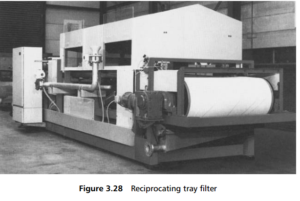0
-
An empty cart
You have no item in your shopping cart
envato-wordpress-toolkit domain was triggered too early. This is usually an indicator for some code in the plugin or theme running too early. Translations should be loaded at the init action or later. Please see Debugging in WordPress for more information. (This message was added in version 6.7.0.) in /var/www/wp-includes/functions.php on line 6121g5plus-darna domain was triggered too early. This is usually an indicator for some code in the plugin or theme running too early. Translations should be loaded at the init action or later. Please see Debugging in WordPress for more information. (This message was added in version 6.7.0.) in /var/www/wp-includes/functions.php on line 6121The vacuum belt filter employs a continuously moving horizontal belt of filter medium, commonly of woven wire mesh, moving between two rollers. In the forward direction, a suspension, of medium to high solids concentration, is fed onto the upper surface of the belt close to one roller. The cake formed in the feed zone is carried through dewatering, washing and drying zones, before being discharged as the belt turns round the other roller. The belt returns to the first roller through a cleaning device of some kind. The vacuum is applied below the filter medium to suck the filtrate through cake and medium, the filtrate leaving the filter through the vacuum connection, to be caught in the filtrate receiver. The main difference among types of vacuum belt filters lies in the way in which the vacuum is applied.
Reciprocating tray machines have vacuum trays that are individually evacuated and clamped by suction onto the underside of the belt. The trays move forward with the belt filter medium at the same speed, acting as a support for it. At the end of each stroke, with filtration and washing completed, the vacuum in the tray is released and the belt continues to move at a constant velocity. The tray is retracted downwards, away from the belt, to return to the start position, to be evacuated and for the process to be repeated. As the trays move with the belts, there are no sealing problems between belt and vacuum space, and so no air in-leakage, and there are no problems of friction, and consequent wear between belt and vacuum box. A typical tray filter is shown in Figure 3.28. This type of belt filter can be constructed from stainless steel or plastics.

The rubber belt filter has a continuous thick rubber belt running underneath the filter medium, to act as support for the medium. This extra belt, which has its own rollers, is grooved and perforated so as to allow the vacuum to reach the filter
belt, and also to accept the drained liquid and pass it to stationary vacuum boxes or trays underneath. As with any horizontal belt filter, the length can be extended to incorporate zones for thorough washing as well as for filtration and dewatering. Reciprocating tray machines are usually lower in cost than rubber belt machines, which tend to provide a higher cloth speed and carry a heavier cake load.
Some solids are difficult to dewater, or at least to dewater sufficiently for the next step in the process, and the required degree of dewatering is achieved by the use of a press belt, which applies a squeezing of the solids to supplement the vacuum. The
press belt may be external to the filter, in which case it takes the form of a short stretch of belt pressed down against the top of the filter cake. The press belt itself is separate from the filter belts, and is supported on, and driven by, a set of rollers
above the main level of the filter.
The press belt feature may, alternatively, be integrated into the main belt filter, by taking the filter belt and cake into a section of additional rollers that compress the press belt on top of the cake. This is then effectively a belt press, as described
in Section 3P .
Gas-tight vacuum belt filters are a valuable development in belt filtration technology. They are required where the solid materials or liquids involved in the process give off fumes, which may be toxic or chemically explosive and/or just create an unpleasant atmosphere or have to be processed in an inert atmosphere. Designs are now available that can provide a nitrogen purged atmosphere as overpressure. A high proportion of gas-tight machines are built for use with alcohols, but a wide range of chemicals including acetone, hexane, methylene chloride, and acetic acid at 90°C have been successfully applied.
Ask for more information please click here.